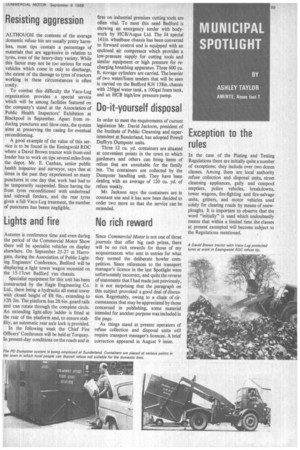MUNICIPAL SPOTLIGHT
Page 75

If you've noticed an error in this article please click here to report it so we can fix it.
BY ASHLEY TAYLOR AMIRTE, Assoc Inst T
Resisting aggression
ALTHOUGH the contents of the average domestic refuse bin are usually pretty harmless, most tips contain a percentage of materials that are aggressive in relation to tyres, even of the heavy-duty variety. While this factor may not be too serious for road vehicles which come in only to discharge, the extent of the damage to tyres of tractors working in these circumstances is often costly.
To combat this difficulty the Vacu-Lug organization provides a special service which will be among facilities featured on the company's stand at the Association of Public Health Inspectors' Exhibition at Blackpool in September. Apart from reducing punctures and blow-outs, the system aims at preserving the casing for eventual reconditioning.
A good example of the value of this service is to be found in the Easingwold RDC where a David Brown tractor with front-end loader has to work on tips several miles from the depot. Mr. E. Canhan, senior public health inspector and surveyor, says that at times in the past they experienced so many punctures in one day that work had had to be temporarily suspended. Since having the front tyres reconditioned with undertread and sidewall fenders, and the rear tyres given a full Vacu-Lug treatment, the number of punctures has beeen negligible.
Lights and fire
Autumn is conference time and even during the period of the Commercial Motor Show there will be specialist vehicles on display elsewhere. On September 25-27 at Harrogate, during the Association of Public Lighting Engineers' Conference, Bedford will be displaying a light tower wagon mounted on the 15-17cwt Bedford van chassis.
Specialist equipment for this unit has been constructed by the Eagle Engineering Co. Ltd., there being a hydraulic all-metal tower with closed height of 8ft 9in., extending to 12ft 2in. The platforrn has 2ft 6in. guard rails and can rotate through the complete circle. An extending light-alloy ladder is fitted at the rear of the platform and, to ensure stability, an automatic rear axle lock is provided.
In the following week the Chief Fire Officers' Conference will be held at Torquay. In present-day conditions on the roads and in fires on industrial premises cutting tools are often vital. To meet this need Bedford is showing an emergency tender with bodywork by HCB/Angus Ltd. The J4 special 141in. wheelbase chassis has been converted to forward control and is equipped with an enclosed air compressor which provides a low-pressure supply for cutting tools and similar equipment or high pressure for recharging breathing apparatus. Three 600 cu. ft. storage cylinders are carried. The heavier of two water/foam tenders that will be seen is carried on the Bedford KH 138in. chassis with 250gal water tank, a 100gal foam tank, and an HCB high/low pressure pump.
Do-it-yourself disposal
In order to meet the requirements of current legislation Mr. David Jackson, president of the Institute of Public Cleansing and superintendent at Sunderland, has adopted Powell Duffryn Dumpster units.
Three 12 cu. yd. containers are situated at convenient points in the town to which gardeners and others can bring items of refuse that are unsuitable for the family bin. The containers are collected by the Dumpster handling unit. They have been dealing with an average of 120 cu. yd. of refuse weekly.
Mr. Jackson says the containers are in constant use and it has now been decided to order two more so that the service can be extended.
No rich reward
Since Commercial Motor is not one of those journals that offer big cash prizes, there will be no rich rewards for those of my acquaintances who sent in entries for what they termed the deliberate howler corn: petition. Since references to the transport manager's licence in the last Spotlight were unfortunately incorrect, and quite the reverse of statements that I had made just previously, it is not surprising that the paragraph on this subject provoked a good deal of discussion. Regrettably, owing to a chain of circumstances that may be appreciated by those concerned in publishing, some material intended for another purpose was included in the page.
As things stand at present operators of refuse collection and disposal units will require transport manager's licences. A brief correction appeared in August 9 issue.
Exception to the rules
In the case of the Plating and Testing Regulations there are initially quite a number of exceptions; they include over two dozen classes. Among them are local authority refuse collection and disposal units, street cleansing appliances, gully and cesspool emptiers, police vehicles, breakdowns, tower wagons, fire-fighting and fire-salvage units, gritters, and motor vehicles used solely for clearing roads by means of snowploughs. It is important to observe that the word "initially" is used which undoubtedly means that within a limited time the classes at present exempted will become subject to the Regulations mentioned.










































































































































